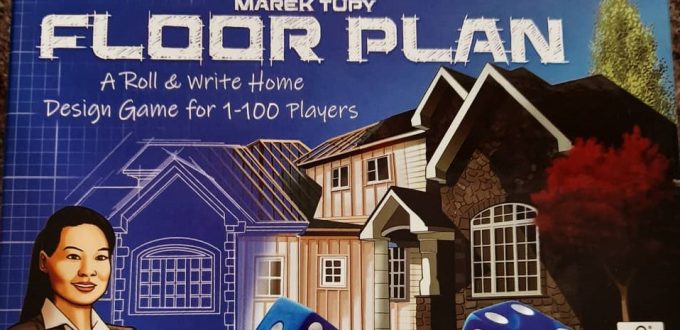Publisher: Deep Water Games
Designer: Marek Tupy
Artist: Dan Dougherty
Release date: 2020
1-100+ Players
Age: 8+
20-40 mins
Favouritefoe score: 7.5/10
Learn More
Please click below to be taken to a 1 minute Rapid Review video.
*Roll and Write * Thinky * Ripe for Expansion * Accessible * Simultaneous Play * Diversity

Shadow Meeple is an architect at heart. Technically he is a project designer, so he gets excited by scaled drawings. I am pretty sure he sees the world in plan form. Every building provides him with an irresistible chance to analyse spaces, flows, and features.
And so, when I heard about Floor Plan, it went straight onto my wish list. Knowing how much it would appeal to him, it would have been cruel not to!
So what is Floor Plan? Will it get you sharpening your HB pencils in delight? Let’s find out!

Sharpen those Pencils!
Floor Plan is a roll and write where you are an architect designing a house for a client. And, like most games in the genre, set up is speedy!
Selecting one card at random from each of the Design, Build, and Layout cards, place them face up. These are the common objectives which every architect will be gunning for. Then give everybody their own sheet and a pencil, and place the two D6 dice in easy reach. You will always start the game by drawing a living room.

Straighten Up and Build Right!
As Floor Plan is a simultaneous action game, once the two dice are rolled, everyone draws at the same time. But each D6 presents you with options from the list on your sheet. And every number on each dice represents a different room or feature.
For example, you roll and get a 2 and a 4. If you choose o draw a room, you will choose one number as the room type. The two dice together then form the dimensions of that room (e.g. a 2 and a 4 could be a 2 x 4 sized Washroom (2) or Kitchen (4)).
Alternatively, if you don’t fancy adding a room, you will select the two sets of features corresponding to those same numbers (e.g. 2 doors (2) and 4 furnishings (4)) and draw them somewhere on your sheet. Your actions on each round are going to be guided by your demanding client, as well as what can be fitted into the ever reducing space on your sheet.
Once you achieve an objective, you write the corresponding number of points in the first available sticky note on the track at the bottom of the sheet. You’ll also gain the bonus action underneath it (for immediate or later use).
When a player has achieved 6 objectives (which can be multiples of the same type or different ones), the game ends and scoring begins!

Ace Architects!
I love roll and write/flip and fill games. They are portable, accessible, and easy to learn. You can play them over video call or around the table. You can play by yourself or with hundreds of others. And, whilst there is a trend towards adding more elements and direct player interaction, sometimes keeping a roll and write straightforward works.
And this is one of those examples. Floor Plan is a simple concept; you roll two dice and make a choice. But it has a subtle layer of calm crunch which I like. It’s not a crazy, sheet swapping, dice rolling noise fest. It is a game where you sit, look, and plan (literally!).
With objectives competing for space and rolls, you will have to make choices. Further, as only very few allow you to utilise the same feature or room twice, your decisions become squeakier as other players fill up their score track and your sheet space diminishes. For that reason, Floor Plan is also on the slightly lengthier side of the genre. Our games have averaged around 35 minutes factoring in my AP proneness.
Diverse Designs!
I must say that I really like the efforts Deep Water Games and the designer, Marek Tupy, have made to promote diversity within the game. With characters from different backgrounds within the artwork and a seamless integration of need-specific objectives, it feels well thought out.


Imperfect Planning!
I will say that Floor Plan isn’t perfect. The sheets are small (and only one sided) and can be hard to see, let alone draw on. The distinction between Design and Build objectives isn’t huge either, but that doesn’t really matter so long as you achieve some!
I am also a little disappointed that I can design a winning house than makes no sense . Perhaps down to my own issues than the game, but a house that has zero bathrooms does not sit well.. It irritates me. In fact, my husband concentrates so much on making his building “work” that he misses most of the objectives (hence my wins!).
For this reason, I think a minimum set of basic requirements on top of common objectives with point penalties for missing out would be better. As a simple fix, we are considering a house rule along these lines.. Similarly, some personal, secret objectives could also help to make Floor Plan even crunchier. They wouldn’t affect what you do (i.e. would not result in hate-drafting). But, if you see a popular room or feature regularly cropping up on another player’s board, it might force you to make different decisions to mitigate those effects at end-game scoring. On that basis, I would say Floor Plan is exciting as it is ideal for lots of fun expansions.
We love building games but nearly all of the ones we own are tile layers. As such, we really enjoy this roll and write twist on construction, and l am really looking forward to seeing what Deep Water Games do with Floor Plan in the future!







